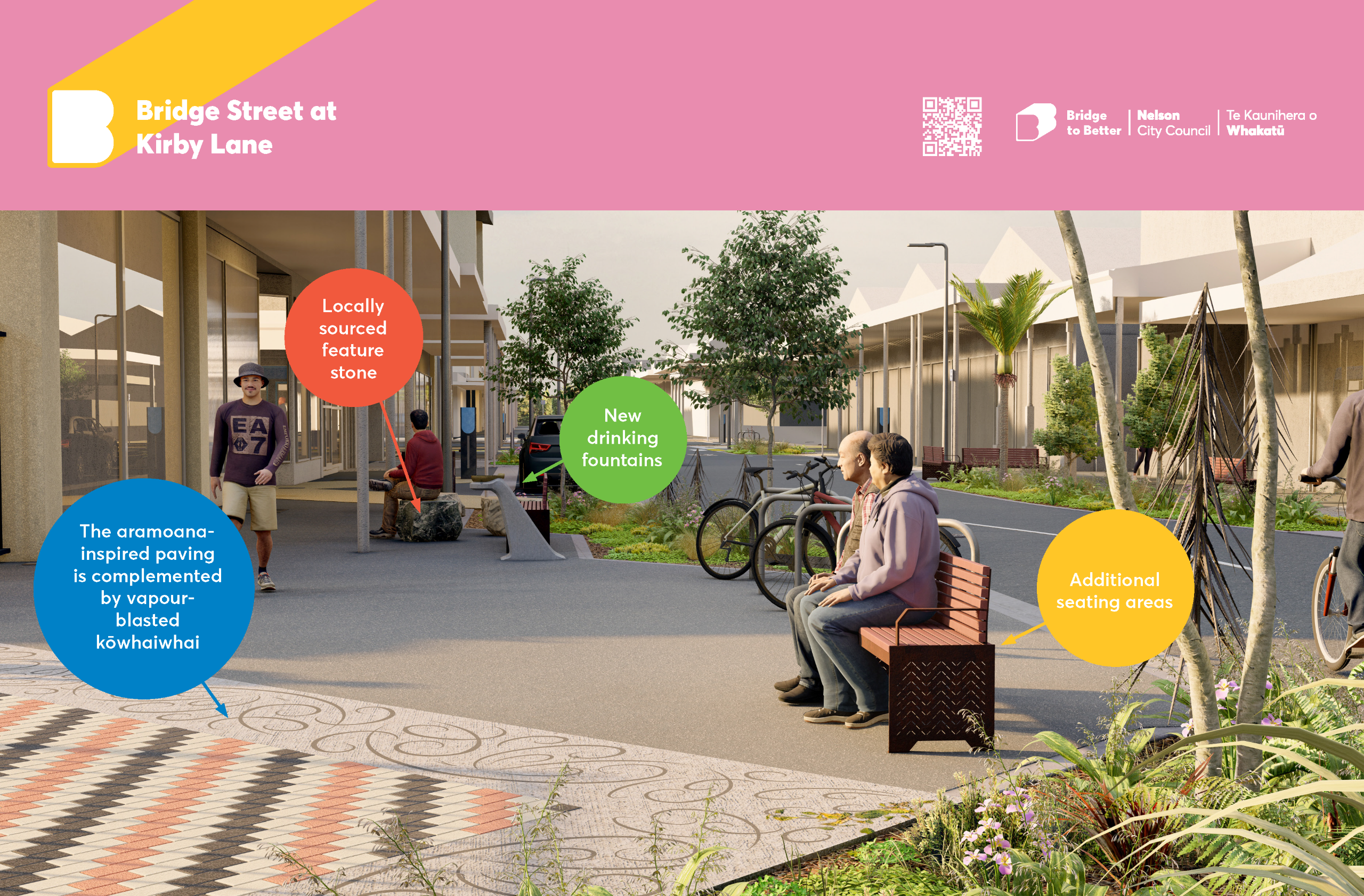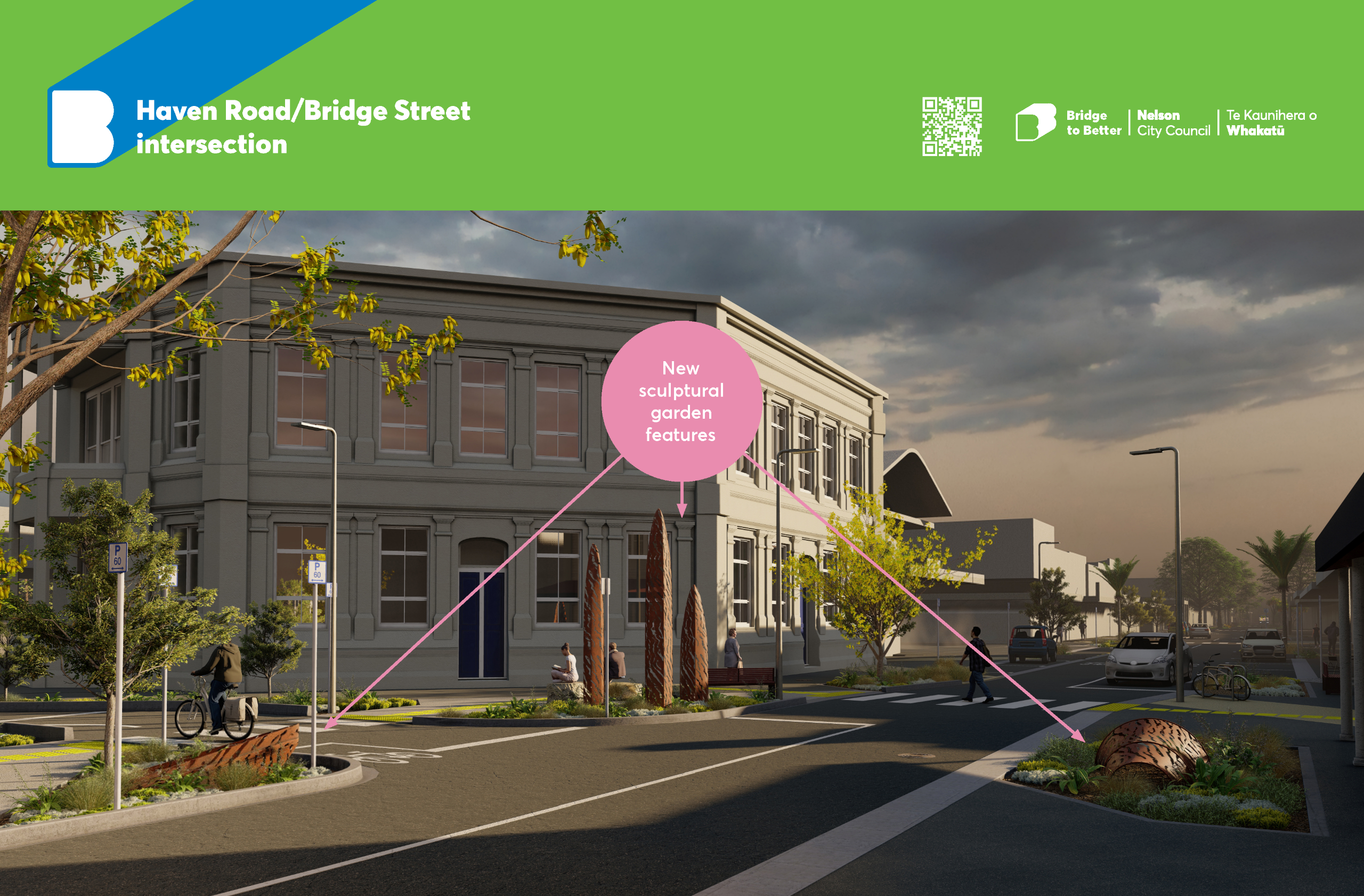A street that tells the story of Nelson
13 October 2025
Bridge Street is being transformed. From the pipes below ground to the paving under your feet, the Bridge to Better project is an investment in Nelson’s transport, three‑waters infrastructure and public spaces that reflect Whakatū Nelson’s unique identity. We have been breaking down the new design for Bridge Street through a series of stories highlighting its key elements and how these changes will support future city growth.
This final part of the series looks at how the new design creates a space for people that reflects Whakatū Nelson’s identity, honours its past, and offers a vibrant destination for everyone to enjoy.
Standing on Bridge Street today, it’s hard to imagine that it was once the edge of Te Paruparu estuary. Beneath the asphalt is the memory of a thriving coastal environment where tides moved freely, and mudflats teemed with life.
The new design for Bridge Street returns those forgotten elements to the surface. The innovative co-design process undertaken for the Bridge to Better project has used a Cultural Design Framework developed with local iwi and supported by input from kaumātua and toi Māori practitioners to provide a blueprint for a street that combines function with the expression of cultural narratives and values unique to Whakatū Nelson.
City Revitalisation Taskforce Chair, Deputy Mayor Rohan O’Neill-Stevens, says the collaboration with iwi has given the project a depth that goes beyond physical design.
“Working alongside iwi has meant this isn’t just a street upgrade, it’s a chance to bring cultural narratives to life in ways that everyone can see and experience. The result is a design that feels authentic to Whakatū and unmistakably Nelson.”
At the heart of the paving design is the aramoana, a geometric tāniko pattern that will zig-zag down the length of the street, reflecting the movement of tidal currents. This will be complemented by curving kōwhaiwhai patterns, vapour-blasted into the paving. The kōwhaiwhai design symbolises tai timu, tai pari, the ebb and flow rhythm of the tides, and was created especially for the project.
Traditional knowledge and contemporary place-making combine through the addition of rāranga (weaving) paving patterns, and feature stones sourced from the region. At the Haven Road intersection, sculptural features, including a tauihu (waka prow), kupenga (fishing net) and waka tū (standing waka), will be situated in feature gardens celebrating waka traditions.
Bridge Street will feel significantly greener with the addition of native plantings, arranged to trace the journey from Te Ngāhere (The Wood) to Te Paruparu (the estuary). The planting palette combines new specimen trees with raingardens and under-planting that transitions from coastal and estuarine species at the Rutherford St end, through to forest species at the Collingwood St end.
“What excites me is that Bridge to Better doesn’t choose between infrastructure, environment or culture — it holds them together. That balance is at the heart of the kaupapa and why this project will feel different from anything Nelson has seen before,” O’Neill-Stevens says.
Wider, kerbless footpaths will make Bridge Street safer and easier to navigate for everyone – whether on foot, with a pram, in a wheelchair, or using mobility aids, and provide a better space for central city events. Event infrastructure will be integrated too, with additional power sites installed for events and food trucks, and new, improved lighting to increase the street’s potential for an enhanced nighttime economy.
New seating will be placed along the street and clustered in some areas to give people more space to gather or rest. Cycle stands will also be placed throughout the street and will include features such as tap rails for blind and low vision members of the community.
Where possible, existing heritage features are being carefully retained. The historic Boulder Bank kerbstones will be used in the pedestrian edges of the flush street, and the familiar heritage verandah poles kept as part of the new layout.
“This project shows the scale of ambition we have for our city,” says O’Neill-Stevens.
“We’re creating a city centre that is vibrant, liveable and supports a thriving local economy, a place that people will want to live in, spend time in and be proud of, now and for generations to come.”
Bridge Street is being re-shaped into more than a route through the city. It will be a place that reflects Whakatū Nelson’s culture and identity in its very fabric, from the plants that will grow there, to the paving and sculptural features. The result will be a space that is both practical and distinctly Whakatū.






